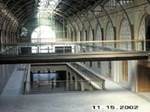Electric ferry runs quietly with composites
Infused sandwich construction hull and superstructure panels offset battery system weight.
For marine transportation operators driven by ever-tighter environmental regulations, emissions and nuisance noise reduction have joined increasing efficiency as top priorities. One means for meeting them all is electric propulsion. A case in point is Stockholm, Sweden’s SL public transportation system and its ferry operator Ballerina, which recently introduced its first battery-powered ferry boat. Featuring a high-tech marine lithium-ion (Li-ion) battery system from Saft Group (Paris, France) the M/S Sjövägen makes 10 stops on a 50-minute route through the Stockholm waterways all year, completing eight round trips per day. Designed and manufactured by boatbuilder Faaborg Vaerft (Faaborg, Denmark) with engineering firm Principia North A/S (Svendborg, Denmark) and marine fire-suppression expert Wilhelmsen Technical Solutions (Lysaker, Norway), the ferry’s composites were a must for the majority of the vessel, to offset the weight of the battery packs.
The ferry’s hull and superstructure feature fiberglass-faced sandwich construction cored with Divinycell H polyurethane/polyvinyl chloride foam, a high-strength closed-cell product with good fatigue resistance and low water uptake, made by Diab International AB (Laholm, Sweden). “We used the sandwich composite panels mainly for the hull, topsides and wheelhouse,” says Jan Ulrich Mortensen, managing director at Faaborg Vaerft. Christian Karlsson, DIAB’s sales/marketing manager for Europe and Asia, says the hull sandwich was layed up in a one-piece mold and infused. The superstructure components were assembled from infused flat panels. “It is a great solution,” sums up Mortensen, “due to its strength, noise reduction and vibration-damping properties.”
Related Content
-
REGENT progresses seaglider prototype development, prepares for crewed testing
All-electric composites-intensive maritime craft will enhance coastal transportation capabilities by mid-decade.
-
The lessons behind OceanGate
Carbon fiber composites faced much criticism in the wake of the OceanGate submersible accident. CW’s publisher Jeff Sloan explains that it’s not that simple.
-
Large-format 3D printing enables toolless, rapid production for AUVs
Dive Technologies started by 3D printing prototypes of its composite autonomous underwater vehicles, but AM became the solution for customizable, toolless production.










.jpg;maxWidth=300;quality=90)


